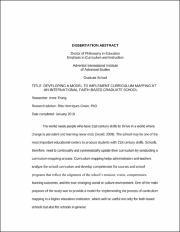Developing a model to implement curriculum mapping at an international faith-based graduate school
Abstract
The world needs people who have 21st century skills to thrive in a world where change is persistent and learning never ends (Jerald, 2009). The school may be one of the most important educational centers to produce students with 21st century skills. Schools, therefore, need to continually and systematically update their curriculum by conducting a curriculum-mapping process. Curriculum mapping helps administrators and teachers analyze the school curriculum and develop competencies for courses and school programs that reflect the alignment of the school’s mission, vision, competencies, learning outcomes, and the ever-changing social or culture environment. One of the main purposes of the study was to provide a model for implementing the process of curriculum mapping in a higher education institution, which will be useful not only for faith-based schools but also for schools in general.
I used a qualitative case study design to explore and explain the experience of the curriculum-mapping experts, practitioners, administrators, teachers, and selected students. I observed administrators, teachers, and students during their initial curriculum mapping meetings and recorded each step of the mapping process over a 2-year period. The participants described their experiences during the mapping process, which included the implementation of the curriculum-mapping results to improve their teaching.
The Taba inductive strategy was used for the data analysis. The findings of the study were intended to help administrators and teachers conduct the mapping process in a systematic way. The main contributions of the study were the development of an innovation configuration map and the description of the cyclical process of curriculum mapping. These were developed based on the experiences of the curriculum-mapping experts, practitioners, administrators, teachers, and students. The innovation configuration map provides an operational definition of the curriculum mapping process and consists of the curriculum-mapping components with variations, which describe different ways of conducting and implementing curriculum-mapping. The study ended with recommendations and suggestions for further studies, which may help other researchers who are interested in conducting the mapping process.


